Boletus L.
Recent molecular studies have shown that Boletus in its current circumscription is likely an artificial grouping and it is possible that it will be split at some point into smaller genera. Note that Boletus impolitus and Boletus depilatus for practical reasons are retained here, although there is strong evidence that they are closely related to Xerocomus subtomentosus and its allies.
Fruitbody large to medium sized, boletoid, without veil and ring. Stipe solid, with surface usually covered with granules or network. Flesh variously coloured, changing or not when exposed to air. Tubes easily separable from each other, not tearing apart. Pores usually small and rounded.
Boletus calopus Pers. : Fr.
Description
Cap up to 15 cm, at first hemispherical, later convex to flat-convex, initially dry, smooth or velevty, then smooth, rarely cracked, sometimes slightly viscid in old fruitbodies, greyish, silvery grey, ochraceous grey or grey with olivaceous tint, unchanging when bruised. Stipe cylindrical, club-shaped or swollen at the base, in the upper 1/3 to 1/2 lemon yellow to yellow, downwards carmine or pinkish red, with concolorous network (f. calopus) or similarly coloured granules (f. ereticulatus Lannoy & Estadès). Flesh in young fruitbodies lemon yellow, later whitish or white in the cap, yellowish in the stipe, blueing when exposed to air. Tubes lemon yellow, later pale yellow with olivaceous tint, blueing when injured. Pores concolorous with the tubes, blueing when bruised. Smell not distinctive. Taste bitter. Spores 11–16 × 4–5.5 μm, ratio 2.2–3.4. Pileipellis trichodermium of interwoven septate hyphae of finely incrusted cylindrical cells. Chemical reactions: hyphae of the flesh in the stipe base strongy amyloid with Melzer’s solution.
Habitat. Broadleaf, mixed and coniferous forests, mycorrhizal with oaks (Quercus), beech (Fagus), spruce (Picea), fir (Abies) or pines (Pinus).
Distribution. Widespread throughout Europe.
Note. Hills & Vassiliades (1999) described a close species from Greece, namely Boletus polygonius. It is distinguished by its cracked cap surface. Cracking of the cap is not unseen in this genus and further collections and research are needed to clarify the status of this entity.
Photograhs

Fruitbodies of Boletus calopus from under conifers. (photo B. Assyov)
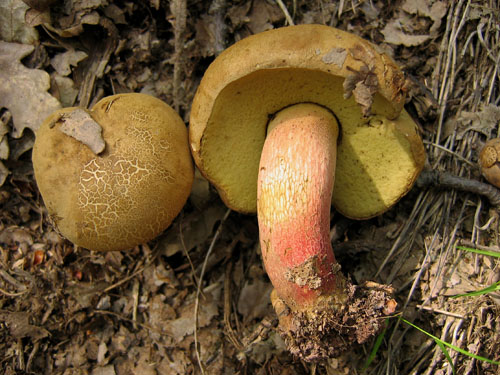
Fruitbodies of Boletus calopus from under deciduous trees. (photo B. Assyov)
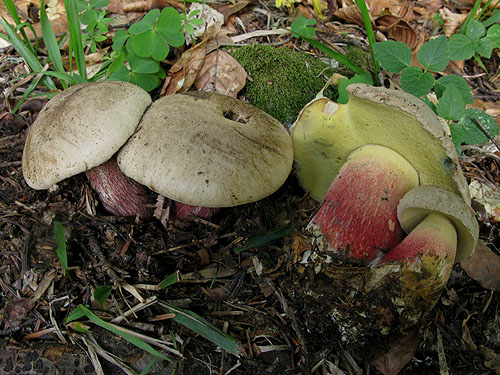
Fruitbodies of Boletus calopus. (photo I. Assyova)

Fruitbodies of Boletus calopus from under conifers. (photo M. Mikšík)
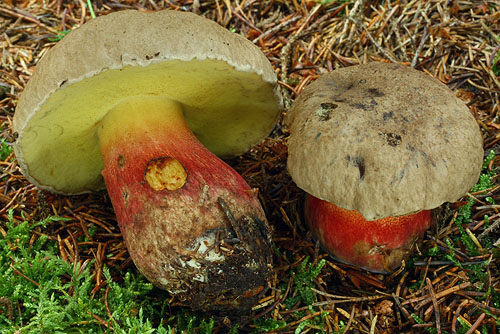
Fruitbodies of Boletus calopus. (photo M. Mikšík)
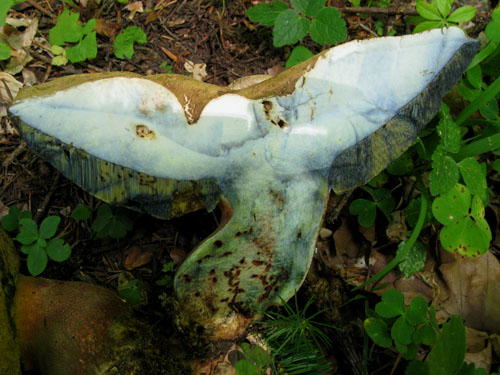
Boletus calopus - blueing of the flesh. (photo I. Assyova)
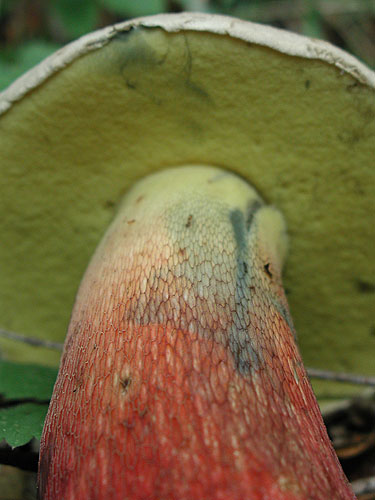
Upper part of the stipe of Boletus calopus. Note the network, the blueing on brusing and the yellow pores. (photo B. Assyov)

Detail of the stipe of Boletus calopus f. ereticulatus. Note the granulated surface and the rudimentary network nearby the pores. (photo B. Assyov)

Spores of Boletus calopus. Scale bar = 10 μm. (photo B. Assyov)
Important literature
Alessio, C.L. 1985. Boletus Dill. ex L. (sensu lato). – In: Fungi Europaei. Vol. 2. Pp. 1–705. Libreria editrice Biella Giovanna, Saronno.
Breitenbach J. & Kränzlin F. 1991. Pilze der Schweiz. Bd. 3(1). Röhrlinge und Blätterpilze. Verlag Mykologia, Luzern.
Engel, H., Krieglsteiner, G., Dermek, A. & Watling, R. 1983. Dickröhrlinge. Die Gattung Boletus in Europa. Verlag Heinz Engel, Weidhausen b. Coburg.
Estadès, A. & Lannoy, G. 2004. Les bolets européens. – Bulletin Mycologique et Botanique Dauphiné-Savoie 44(3): 3–79.
Galli, R. 1998. I Boleti. Atlante pratico-monographico per la determinazione dei boleti. Edinatura, Milano.
Hansen, L. & Knudsen, H. 1992. Nordic Macromycetes. Vol. 2. Polyporales, Boletales, Agaricales, Russulales. Nordsvamp, Copenhagen.
Hills, E.A. & Vassiliades, D. 1999. Boletus polygonius sp. nov., a species of Boletus sect. Calopodes from Greece. – Mycologist 13: 159–161.
Knudsen, H. & Vesterholt, J. [eds.]. 2008. Funga Nordica. Nordsvamp, Kopenhagen.
Lannoy, G. & Estadès, A. 2001. Les Bolets. Flore mycologique d’Europe. Documents Mycologiques Mémoire Hors série no. 6. Pp. 1–163. Association d’Écologie et de Mycologie, Lille.
Muñoz, J.A. 2005. Boletus s. l. – In: Fungi Europaei. Vol. 1. Pp. 1–951. Edizioni Candusso, Alassio.
Pilát, A. & Dermek, A. 1974. Hríbovité huby. Československé hríbovité a sliziakovité huby (Boletaceae – Gomphidiaceae). Veda, Bratislava.
Singer, R. 1967. Die Röhrlinge. II. Die Boletoideae und Strobilomycetaceae. – In: Die Pilze Mitteleuropas. Vol. 6. Pp. 1–151. Julius Klinkhardt Verlag, Bad Heilbrunn.
Šutara, J., Mikšík, M. & Janda, V. 2009. Hřibovité houby. Čeled’ Boletaceae a rody Gyrodon, Gyroporus, Boletinus a Suillus. Academia, Praha.
Watling, R. 1970. Boletaceae, Gomphidiaceae, Paxillaceae. – In: Henderson, D.M., Orton, P.D. & Watling, R. [eds]. British fungus flora. Agarics and Boleti. Vol. 1. Royal Botanic Garden, Edinburgh.
Watling, R. & Hills, A.E. 2005. Boletes and their allies (revised and enlarged edition). – In: Henderson, D.M., Orton, P.D. & Watling, R. [eds]. British Fungus Flora. Agarics and boleti. Vol. 1. Royal Botanic Garden, Edinburgh.